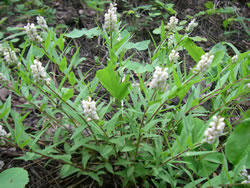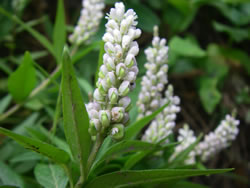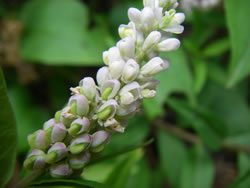Plant of the Week
 Polygala senega range map. USDA PLANTS Database.
Polygala senega range map. USDA PLANTS Database.
 Seneca snakeroot (Polygala senega) plant growth habit, as seen in the northern Black Hills of South Dakota. Photo by Jill Larson Welborn.
Seneca snakeroot (Polygala senega) plant growth habit, as seen in the northern Black Hills of South Dakota. Photo by Jill Larson Welborn.
 Seneca snakeroot (Polygala senega) flower raceme. The lower portion of the spike like raceme shows the green fruiting capsules. Photo by Jill Larson Welborn.
Seneca snakeroot (Polygala senega) flower raceme. The lower portion of the spike like raceme shows the green fruiting capsules. Photo by Jill Larson Welborn.
 A closer look at the flower raceme of Seneca snakeroot (Polygala senega). Photo by Jill Larson Welborn.
A closer look at the flower raceme of Seneca snakeroot (Polygala senega). Photo by Jill Larson Welborn.
Seneca Snakeroot (Polygala senega L.)
By Jill Larson Welborn, Botanist, Northern Hills Ranger District, Black Hills National Forest, July 2011
Seneca snakeroot (Polygala senega L.) is a member of the milkwort family (Polygalaceae). Although it is widely distributed throughout eastern and northern North America, it is of conservation concern in a substantial portion of its range. Seneca snakeroot is collected extensively for its root, which has a number of medicinal uses. Manitoba has been the main exporter of the plant for medicinal trade.
There may be two taxonomic varieties of Seneca snakeroot, the typical variety (Polygala senega var. senega) and Polygala senega var. latifolia. Some sources recognize the two varieties, while others do not. Seneca snakeroot is a perennial 15 to 30 centimeters tall, with a taproot and few to several simple stems from a thick, woody crown. The leaves are spirally arranged, ovate to ovate-lanceolate or elliptic-lanceolate, 1 to 3 centimeters long. The white flowers are arranged in a spike like, conic raceme 1.5 to 4 centimeters long. Flowers consist of five sepals, the outer three sepals 1 to 1.5 millimeters long, the two lateral sepals 2 to 3 millimeters long. The three petals are united into a greenish-white tube, shorter than the lateral sepals. The lower petal is broad and folded with eight fingerlike projections at its tip, and enclosing usually eight very small stamens. Fruit is a two-valve, two-seeded capsule.
Habitats reported for Seneca snakeroot range from rocky, thin soils to mesic woodlands, and even prairies and steppe vegetation. It is often associated with calcareous gravels or bedrock. The plant’s ecological requirements are poorly understood. The Black Hills and Bearlodge Mountains straddling the South Dakota and Wyoming border are the westernmost extent of the species’ range in the United States. Seneca snakeroot is found intermittently in this region, especially in the rich, moist Ponderosa pine and white spruce forests of the northern Black Hills.

